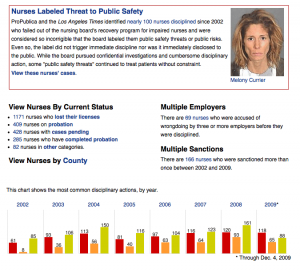Update (12/30): So about an eon later, I’ve updated this by writing a guide for ProPublica. Heed that one. This one will remain in its obsolete state.
Update (4/28): Replaced the code and result files. Still haven’t written out a thorough explainer of what’s going on here.
Update (4/19): After revisiting this script, I see that it fails to capture some of the payments to doctors associated with entities. I’m going to rework this script and post and update soon.
So the world’s largest drug maker, Pfizer, decided to tell everyone which doctors they’ve been giving money to to speak and consult on its behalf in the latter half of 2009. These doctors are the same ones who, from time to time, recommend the use of Pfizer products.
Pfizer, the world’s largest drug maker, said Wednesday that it paid about $20 million to 4,500 doctors and other medical professionals for consulting and speaking on its behalf in the last six months of 2009, its first public accounting of payments to the people who decide which drugs to recommend. Pfizer also paid $15.3 million to 250 academic medical centers and other research groups for clinical trials in the same period.
A spokeswoman for Pfizer, Kristen E. Neese, said most of the disclosures were required by an integrity agreement that the company signed in August to settle a federal investigation into the illegal promotion of drugs for off-label uses.
So, not an entirely altruistic release of information. But it’s out there nonetheless. You can view their list here. Jump to my results here
 Not bad at first glance. However, on further examination, it’s clear that the list is nearly useless unless you intend to click through all 480 pages manually, or, if you have a doctor in mind and you only care about that one doctor’s relationship. As a journalist, you probably have other questions. Such as:
Not bad at first glance. However, on further examination, it’s clear that the list is nearly useless unless you intend to click through all 480 pages manually, or, if you have a doctor in mind and you only care about that one doctor’s relationship. As a journalist, you probably have other questions. Such as:
- Which doctor received the most?
- What was the largest kind of expenditure?
- Were there any unusually large single-item payments?
None of these questions are answerable unless you have the list in a spreadsheet. As I mentioned in earlier lessons…there are cases when the information is freely available, but the provider hasn’t made it easy to analyze. Technically, they are fulfilling their requirement to be “transparent.”
I’ll give them the benefit of the doubt that they truly want this list to be as accessible and visible as possible…I tried emailing them to ask for the list as a single spreadsheet, but the email function was broken. So, let’s just write some code to save them some work and to get our answers a little quicker.
Continue reading



